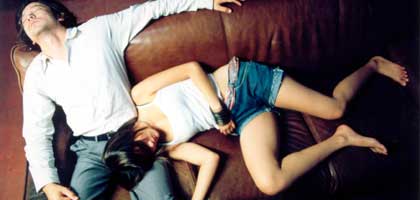
Last Life in the Universe
Thailand/Netherlands/Hong Kong/UK 2003

Reviewed by Ryan Gilbey
Synopsis
Our synopses give away the plot in full, including surprise twists.
Kenji (Tadanobu Asano), who works as a librarian at the Japanese Cultural Centre in present-day Bangkok, entertains suicidal fantasies. As he is about to hang himself, his brother, who is on the run, arrives with a mysterious package and moves in. Later, Kenji's brother brings an associate back to the apartment. The man shoots dead Kenji's brother, and is in turn killed by Kenji, who has opened his brother's package to discover a gun inside. Kenji is perched on a bridge, preparing to throw himself into the river below. Behind him, a teenage girl named Nid (Laila Boonyasak), whom Kenji has seen earlier in the library, gets out of her sister's car and is mown down. Kenji accompanies Nid's sister Noi (Sinitta Boonyasak) to the hospital, where Nid dies.
Kenji and Noi go back to Noi's house, where they stay for the next few days. The pair gradually grow closer, despite the threats of Noi's ex-boyfriend, who attacks Noi before Kenji intervenes. Eventually it is time for Noi to leave for her studies in Osaka. Travelling in the opposite direction are three yakuzas hunting Kenji's brother. At Kenji's apartment, they find and kill Noi's ex-boyfriend, who had come looking for Kenji. Kenji himself, who was in the bathroom when the yakuzas arrived, is last seen handcuffed in a police interview room, speculating on Noi's new life.
Review
For his fourth feature, Last Life in the Universe, the Thai director Pen-Ek Ratanaruang attempts to tell in abstract terms what could have been a fairly generic story, about a loner, Kenji, who hides out with a beautiful young woman after killing his brother's assassin. The picture is set in Bangkok, but the under-populated locations suggest some kind of netherworld. The apartment inhabited by the suicidal librarian Kenji might have come out of a flat-pack. The bleached-out, off-season seafront resembles Wigan with palm trees.
Kenji's suicidal fantasies are played out as if they were real, and it's tempting to conclude that he has succeeded in one of his numerous suicide attempts, and is actually drifting through the afterlife. This reading is supported by the enigmatic title, and by its appearance on screen a full 35 minutes into the movie, prior to Kenji moving in with Noi, the young woman he has met, imposing on the action a sense of 'before and after'. The mystery of whether Kenji is dead or alive is soon supplanted by the question of whether anyone will answer the telephone that rings constantly in Noi's house. It might be a symbol for the characters' failure to communicate, or their enduring loneliness; it is also a mighty distraction from the film's sparsely beautiful score.
But then Last Life in the Universe quickly comes to seem like a movie built on wilful misjudgements. It's an unsuccessful experiment in combining genres that are as irreconcilable as oil and water. Those parts of the movie that are primarily plot-driven, involving such stock elements as a trio of yakuzas and a concealed gun that is discovered by Kenji in time to be used in self-defence, strike a note of half-hearted pastiche. There is a whiff of Tarantino about the gangster who explains his lack of baggage to a check-in assistant by hissing: "We only go to kill someone, then come straight back," while Pulp Fiction (1994) springs inevitably to mind when Kenji is detained in the bathroom by a bout of diarrhoea as a shoot-out takes place in his living room.
The superior material, closer in tone to Ratanaruang's bittersweet Mon-rak Transistor (2002), is confined to the film's middle section, focusing on Kenji and Noi. Here the picture incorporates magical realism: the scene in which vases and books dance back on to their shelves as if by the hand of a poltergeist echoes the giddy joy of the 'Sorcerer's Apprentice' sequence from Fantasia (1940). Kenji occasionally imagines that Noi is actually her late sister Nid, with whom he has become fascinated. Ratanaruang obligingly mixes up the actresses, who are real-life sisters, just as Buñuel cast Ángela Molina and Carole Bouquet in the same part in That Obscure Object of Desire (1977).
It's hard to see what Ratanaruang and his co-writer, the novelist Prabda Yoon, thought they might be making with this unusual hybrid work, this graft that doesn't take. Neither of the film's distinct sections provides nourishment to the other. There is just enough narrative to make it frustrating that more of the guesswork hasn't been eliminated from the plot, but too much to allow the relationship between Kenji and Noi to unfold at an organic pace. This is a film that won't surrender even the most fundamental data. Time and place, chronology of events, the distinction between life and death - these things are secondary to an atmosphere of obtuse whimsy. Strange, then, that this atmosphere is readily disrupted with pointless in-jokes relating to Ichi the Killer (2002), the star (Tadanobu Asano) and director (Takashi Miike) of which both feature in the cast.
It's fitting that, in a movie which represents a tug of war between incompatible ideas and styles, Ratanaruang appears throughout to be wrestling for control with Christopher Doyle. This cinematographer brings to his work a more forceful personality even than some directors. That was the problem on Motel Cactus (1997), where Doyle swamped Park Ki Yong's sense of his own film, and it becomes an issue again on Last Life in the Universe. So many of the most emotionally rich scenes are diminished by Doyle's decision to shoot Noi's house like a poverty-chic fashion spread from an early-1990s issue of The Face or i-D. If that wasn't the director's idea, he should have said no, just as he should have vetoed the camera moving under a table mid-scene to observe a panting dog, or loitering at the back of a fridge as the door is opened, both for no apparent reason.
Credits
- Director
- Pen-Ek Ratanaruang
- Producers
- Nonzee Nimibutr
- Duangkamol Limcharoen
- Wouter Barendrecht
- Screenplay
- Prabda Yoon
- Pen-ek Ratanaruang
- Director of Photography
- Christopher Doyle
- Editor
- Pattamanadda Yukol
- Production Designer
- Saksiri Chantarangsri
- Music
- Hualampong Riddim
- SmallRoom
